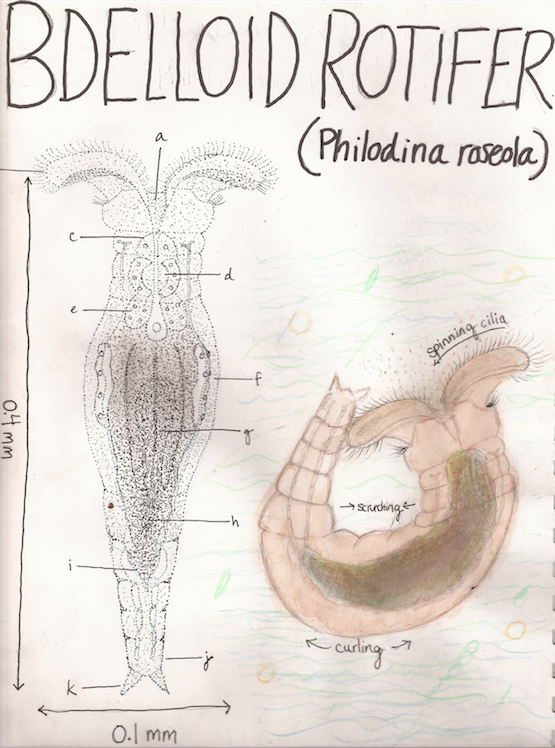TAXONOMY:
Kingdom: Animalia
Eumetazoa
Bilateria
Protostomia
Lophotrochozoa
Rotifera
Class: Eurotatoria
Order: Bdelloidea
Family: Philodinidae
Philodina roseola is otherwise known as the common rotifer. Rotifers are microscopic, aquatic animals that inhabit both still and flowing freshwater environments. They inhabit the thin films of water that surround particles of soil. They can be found in many moist environments, including mosses and lichens, soil litter, sewage treatment plants, mushrooms, and on other microscopic organisms. Bdelloid rotifers are occasionally found in marine or brackish waters as well. Even though they are microscopic, rotifers are recognized as animals because of their specialized organs and complete digestive tract. The rotifer’s head is surrounded by a corona of cilia, drawing a vortex of water into the mouth, which is then sifted for food. The food is then ground by trophi (jaws) in the pharynx (throat). The toe of the rotifer ends in a cement gland, which allows the rotifer to attach itself to a surface and feed without drifting away. Bdelloid rotifers are all female – they use parthenogenesis to create daughters from unfertilized eggs. They can survive drying through a process called cryptobiosis that stops all metabolic processes. Rotifers are a reliable food source for copepods, fish, starfish, and jellies.
ILLUSTRATION KEY:
A – mouth
B – corona
C – cerebral ganglion
D – mastax
E – digestive gland
F – pseudocel
G – stomach
H – intestine
I – anus
J – foot
K – toe
REFERENCES:
Introduction to the Rotifera. (n.d.). Retrieved November 16, 2015, from http://www.ucmp.berkeley.edu/phyla/rotifera/rotifera.html
Marini, F. (2002, September 1). The Breeder’s Net: The Rotifer and Rotifer Home Culture. Advanced Aquarist.





